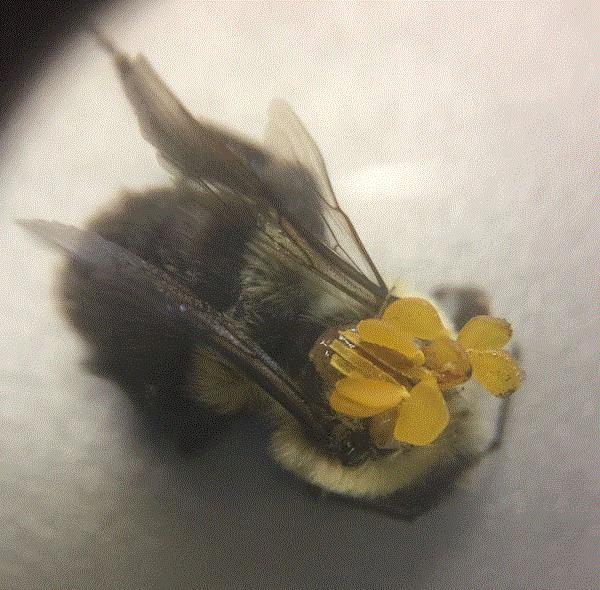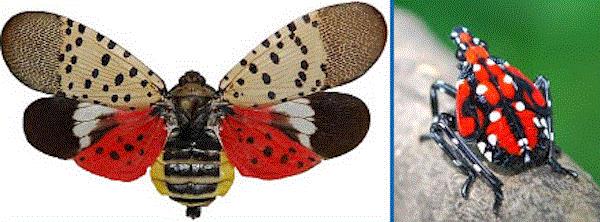What the ... ?
My friend, Tony Bertauski, who teaches and directs the Horticulture Program at Trident Technical College in Charleston, South Carolina, sent me this picture. He and his students found this interesting combination in their teaching greenhouse:

This bumble bee has something weird stuck to it. (Photo credit: Tony Bertauski)
So, a question for y’all: What is going on here? No, no, I don’t mean the bumble bee; that’ll be too easy. What are those yellow flakes attached to the bee? I had a “what the … ?” moment when I first saw the picture.
I’m not going to tell you the answer today. Instead, I’ll let you play the sleuth, and give you a chance to win a prize! It stumped me, but I hope you’ll do better.
The first five persons to send me the correct answer via email (by clicking on my name at the end of this newsletter) will get a copy of the 2018 Southeastern US Pest Control Guide for Nursery Crops and Landscape Planting. Don't judge a book by its title; this guidebook is applicable to all ornamental sites throughout the country. Okay, I'll admit, we are still working on the 2018 edition, but I’ll send you a copy once it’s done in a few weeks.
The answer and the winners will be announced in the next newsletter.

War on spotted lanternfly
January 10, 2018, an otherwise uneventful day, turned out to be an important day to people who care about invasive pests in Virginia. That was the day that spotted lanternfly was detected in Frederick County, Virginia.
Despite its funny name, the spotted lanternfly is a beauty. It doesn't light up and it’s not a fly, it’s a planthopper. Adults are about 1 in. long, pretty big for planthoppers. Forewings are light brown with black spots and tiny black rectangles near the tips. Hind wings are a mix of red, black spots and black and white patches. A live, resting adult holds its wings tent-like over its body. Nymphs are wingless. Young nymphs are black with white spots, and older nymphs are red, with black lines and white spots. With those bright colors and patterns, you’d have to be blind to miss them!

Aren't they pretty? (Photo credit: Pennsylvania Department of Agriculture)
Spotted lanternfly suck sap from trees, so infestation is often associated with sooty mold and honeydew. Feeding can stunt growth and reduce yield of trees.
The Chinese have known about spotted lanternfly since the 12th century. It was even used in traditional Chinese medicine. The first detection on our side of the pond was in Berks County, Pennsylvania, in 2014. Typical of many invasive species that can survive hitchhiking on our moving vehicles and plants, the spotted lanternfly has spread rapidly. In Pennsylvania, the number of counties quarantined by the Pennsylvania Department of Agriculture has grown from one in 2014 to 13 in 2017, all of them in the eastern part of the state. Delaware and New York also have one infested county each. USDA estimates that infested area has increased from 174 square miles in 2015 to about 3,000 square miles in 2017.
Now the Feds are involved. On February 7, USDA-APHIS announced an emergency funding of $17.5 million to combat this pest. The money will be used for survey, control, outreach and public education efforts. Survey and control (if needed) will be conducted in high-risk areas in Delaware, Maryland, New Jersey, New York, Pennsylvania and Virginia.
You’re probably thinking, “Okay, it’s a pretty bug. But what’s the big deal and why are we spending so much money on it?” I also thought, since one of its primary hosts is the tree-of-heaven, we could probably use them as biological control agents of the invasive plant.
Walker Miller of the Happy Berry Farm in Six Mile, South Carolina, promptly schooled me on why a yahoo like me should care about this pest. The spotted lanternfly is known to feed on more than 70 plant species, which include grape, hops, peach, apple, oak, maple, and various fruit, nut and ornamental tree species.
Now, hops and peaches got my attention. Anything that threatens my beer and peach cobbler supplies will have to be dealt with! So, ornamental and fruit producers unite! Keep a lookout for this pest and report them if you see them.
By the way, the spotted lanternfly’s cousins often sport a protruding “nose” from the front of their heads. The spotted lanternfly is the flat-faced black sheep in the family. It’s a myth that the protrusion glows in the dark. Nonetheless, the name sticks.

New herbicide crop safety summaries published by IR-4
IR-4 Project published research summaries on the crop safety of five herbicides this week. I mentioned before that IR-4 provides funding to entomologists, pathologists and weed scientists to conduct efficacy and crop safety trials. (Full disclosure: I also receive funding from IR-4 to do these works.) Once studies are completed, the project’s staff writes up research summaries and posts them on their website.
I like to get my information from trusted sources. So, I find these summaries to be wonderful sources of information on efficacy and crop safety of insecticides, herbicides, fungicides and plant growth regulators.
The new summaries are for dimethenamid-p (Tower), dithiopyr (Dimension), oxyfluorfen + prodiamine (Biathlon), pendimethalin + dimethenamid-p (FreeHand), and prodiamine + Isoxaben (Gemini). I’m sure you are using these preemergent herbicides and learning about their dos and don’ts. These summaries will give you more information on the phytotoxicity of the listed herbicides for many woody and herbaceous plants, so you can use the products more confidently and effectively.

Traction fungicide for golf courses
The last bit of news comes from Nufarm:
Nufarm introduced its new fungicide, called Traction, at the Golf Industry Show this week. This fungicide is registered for golf course turf only. I know, I know, y’all grow ornamental plants and many probably couldn't care less about turfgrass. But, indulge me and let me cater to my readers who do care about golf turf.
This fungicide is a premix of fluazinam (FRAC 29) and tebuconazole (FRAC 3). Neither active ingredient is new to the turf market. The trade names are Secure for fluazinam, and Torque for tebuconazole. The combination of fluazinam and tebuconazole allows this product to target a broad range of turf diseases, including anthracnose, brown patch, dollar spot and snow mold. Traction is now registered for most of the country, except for nine states.
See y'all next time!

JC Chong
Associate Professor of Entomology at Clemson University
This e-mail received by 24,469 subscribers like you!
If you're interested in advertising on PestTalks contact Kim Brown ASAP!